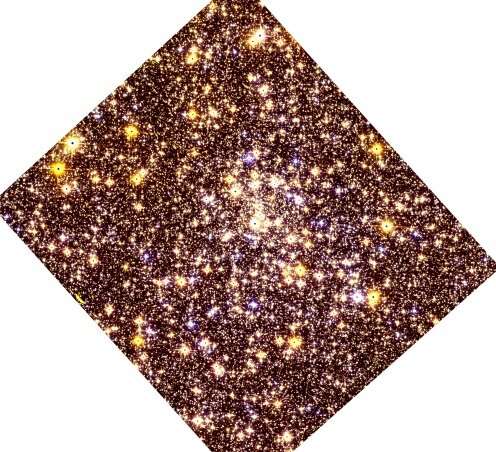July 9, 2019 report
Djorgovski 2 is a moderately metal-poor globular cluster, study finds

Based on data from the Hubble Space Telescope (HST) and from the Very Large Telescope (VLT), astronomers have gained insights into a galactic globular cluster known as Djorgovski 2. Besides determining fundamental parameters of the object, the new research classified Djorgovski 2 as a moderately metal-poor globular cluster. The findings are presented in a paper published June 27 on arXiv.org.
Observations of globular clusters (GCs) in the Milky Way galaxy are of high importance for astronomers as they are among the oldest objects in the universe. Therefore, they are perceived as natural laboratories for the study of stellar evolution processes.
Discovered in 1978, Djorgovski 2 (also known as ESO 456-SC38) is a globular cluster located in the galactic bulge, one of the closest GCs to the center of the Milky Way. Given their location, such clusters as Djorgovski 2 are among the oldest known to date. This could mean that they might have witnessed the entire history of the Milky Way, and could therefore be crucial in advancing the knowledge about our home galaxy.
So a group of astronomers led by Sergio Ortolani of University of Padua, Italy, decided to investigate Djorgovski 2. They analyzed the available observational data regarding this cluster, mainly photometry from HST and VLT. The analysis was complemented by data from ESA's Gaia satellite.
"We analyzed ESO456-SC38 based on Hubble Space Telescope photometry, with the filters F606W from ACS, F110W and F160W from WFC3, and photometry in V and I from FORS2 at the VLT. We combined this with identified stars that are covered by Gaia Data Release 2," the astronomers wrote in the paper.
The main goal of the study was to derive the cluster's accurate distance, metallicity and orbital parameters. Next, these results were used to compare Djorgovski 2 with other clusters in the inner bulge that have previously been well studied photometrically and spectroscopically.
According to the study, Djorgovski 2 has an accurate distance of approximately 28,500 light years, a metallicity of -1.11 and is some 12.7 billion years old. The researchers found that the cluster has a relatively eccentric orbit, with an eccentricity greater than 0.7. The orbit increases with the pattern speed of the galactic bar, with a radial distance between 330 and 8,150 light years from the center of the Milky Way and a maximum vertical excursion between 1,630 and 4,900 light years.
The metallicity of Djorgovski 2 allowed the researchers to categorize it as a moderately metal-poor cluster. Furthermore, they noted that the cluster is on the blue horizontal branch, and is projected very close to the galactic center.
"ESO 456-SC38 adds to the list of moderately metal-poor globular clusters located in the inner bulge. It is on the blue horizontal branch and is very old. The cluster is confined to the bulge and bar region, but it does not support the galactic bar structure," the authors of the paper concluded.
More information: S. Ortolani et al. Another relic bulge globular cluster: ESO 456-SC38 (Djorgovski~2), arXiv:1906.11863v1 [astro-ph.GA]: arxiv.org/abs/1906.11863
© 2019 Science X Network




















